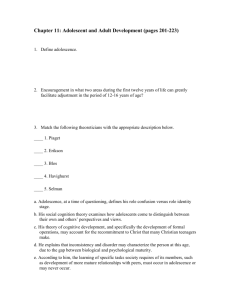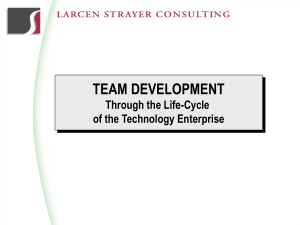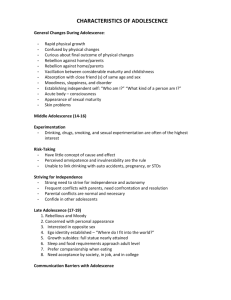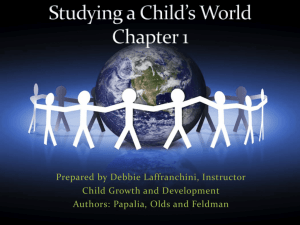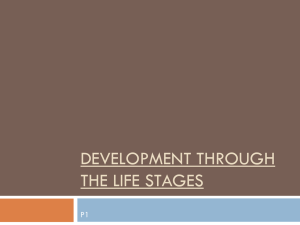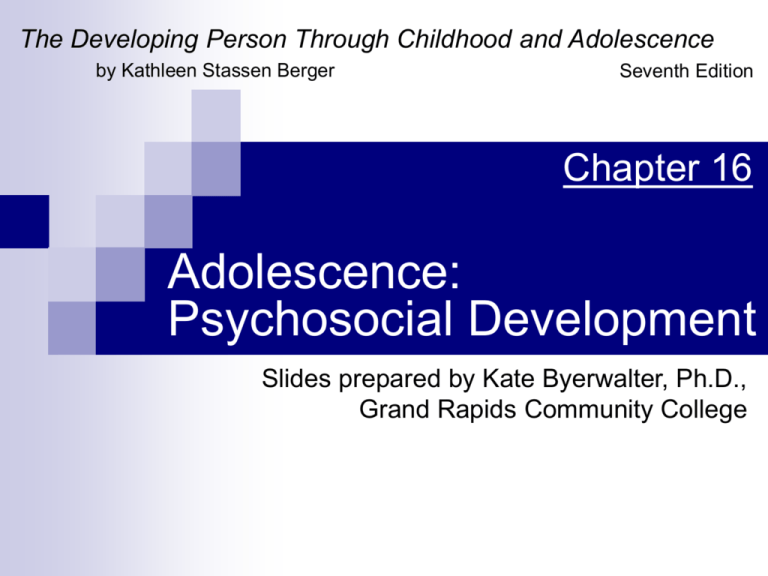
The Developing Person Through Childhood and Adolescence
by Kathleen Stassen Berger
Seventh Edition
Chapter 16
Adolescence:
Psychosocial Development
Slides prepared by Kate Byerwalter, Ph.D.,
Grand Rapids Community College
Self and Identity
Erikson’s fifth stage
of psychosocial
development is
identify vs.
diffusion. It
involves the
question, “Who
am I?”
PHOTODISC
Berger: The Developing Person Through Childhood and Adolescence, 7th Edition, Chapter 16
Multiple Selves
Possible selves: various intellectual
fantasies about what the future might
bring if one or another course of action is
chosen
False self: set of behaviors that is
adopted by a person to combat rejection,
to please others, or to try out as a
possible self
Berger: The Developing Person Through Childhood and Adolescence, 7th Edition, Chapter 16
Paths to Identity
Identity achievement: knowing who one
is as a unique person, accepting some
cultural values and rejecting others
This
allows a person to have strong
convictions, but to remain open to alternate
ideas and opinions.
Berger: The Developing Person Through Childhood and Adolescence, 7th Edition, Chapter 16
Paths to Identity (cont.)
Identity diffusion: a lack of values,
traits or commitments
Foreclosure: adopting preset roles
and values, without questioning
Foreclosure
may lead to prejudice,
narrow-mindedness.
Berger: The Developing Person Through Childhood and Adolescence, 7th Edition, Chapter 16
Paths to Identity (cont.)
Moratorium: a pause in identify formation,
in which alternatives are explored
This
is an important step towards identity!
Negative identity: a rebellious, defiant
identity, taken on to anger adults
Berger: The Developing Person Through Childhood and Adolescence, 7th Edition, Chapter 16
Make it Real: Identity
On paper, place yourself in an identity status
for each of the following arenas:
Religion
Ethnic identity
Sexual orientation
Politics
Career
Education
Berger: The Developing Person Through Childhood and Adolescence, 7th Edition, Chapter 16
Religious Identity
Many adolescents take longer than age 18
to achieve religious identity. Struggling
with questions is an important part of the
commitment.
Example:
The Amish encourage adolescents
to go into the “real world” temporarily.
Berger: The Developing Person Through Childhood and Adolescence, 7th Edition, Chapter 16
Gender Identity
Gender identity is the degree to which
people see themselves as masculine or
feminine.
This includes gender roles (duties), and
sexual orientation (towards same or
opposite sex, or both).
Berger: The Developing Person Through Childhood and Adolescence, 7th Edition, Chapter 16
Ethnic Identity
Ethnic identity involves identification with
a particular ethnicity through values, diet,
gender roles, language, clothing, etc.
The process of ethnic identity may be
especially intense for immigrant
adolescents.
Berger: The Developing Person Through Childhood and Adolescence, 7th Edition, Chapter 16
Make it Real: Vocation and
Identity
What are some of the advantages and
disadvantages of working during
adolescence?
How much of a connection do you see
between the types of jobs had during high
school, and those you have or will have in
adulthood?
Berger: The Developing Person Through Childhood and Adolescence, 7th Edition, Chapter 16
Vocation and Identity
Research has found that working during
adolescence impedes identity formation,
family relationships, academic
achievement, and career success.
Also, the types of jobs don’t tend to teach
skills for later vocations.
Berger: The Developing Person Through Childhood and Adolescence, 7th Edition, Chapter 16
Support from Adults
The “generation gap” between adults and
teens is not wide when it comes to core
beliefs and values.
However, each generation does view
interactions from his/her own perspective
(generational stake).
Berger: The Developing Person Through Childhood and Adolescence, 7th Edition, Chapter 16
Generational Stake: An Example
A young Indian American
girl wanted the freedom
and independence of
cutting her hair. Her
elders considered hair an
essential part of being a
“good Indian girl.”
PHOTODISC
Berger: The Developing Person Through Childhood and Adolescence, 7th Edition, Chapter 16
Make it Real:
What’s your prediction?
At what age would you suppose
parent-child conflict to be greatest?
What are parent-child conflicts about?
What does parent-child conflict a
signal?
Berger: The Developing Person Through Childhood and Adolescence, 7th Edition, Chapter 16
Parent-Child Conflict
NANCY RICHMOND / THE IMAGE WORKS
Berger: The Developing Person Through Childhood and Adolescence, 7th Edition, Chapter 16
Parent-Child Conflict (cont.)
Is greatest during child’s tween years (10−13)
Is greatest between mothers and daughters
Usually involves repeated, petty arguments
about clothes, cleanliness, etc.
Represents a teens desire for independence
Berger: The Developing Person Through Childhood and Adolescence, 7th Edition, Chapter 16
Culture and Family
Some have argued that adolescent
rebellion is a product of Western culture.
Parent-child conflict occurs later in
adolescence for Asian and Latino teens,
and hardly at all for teens in China.
Berger: The Developing Person Through Childhood and Adolescence, 7th Edition, Chapter 16
Aspects of Parent-Teen
Relationships
Communication
Support
Connectedness
Control
PHOTODISC
Berger: The Developing Person Through Childhood and Adolescence, 7th Edition, Chapter 16
Parental Monitoring
Parental monitoring involves ongoing
awareness of what a teen is doing, where,
and with whom.
It deters delinquency.
Berger: The Developing Person Through Childhood and Adolescence, 7th Edition, Chapter 16
Make it real: Parental Monitoring
Is it possible to have too much
monitoring? What would be the result?
Berger: The Developing Person Through Childhood and Adolescence, 7th Edition, Chapter 16
Peer Relationships
Peer pressure: social pressure to conform
to one’s contemporaries
Peer pressure can be positive or
negative.
It rises during early adolescence, peaking
around age 14 years of age.
Berger: The Developing Person Through Childhood and Adolescence, 7th Edition, Chapter 16
Peer Friendships
Selection: peers choose one another
Example:
Drug users hang out with drug
users, high achievers with high achievers.
Facilitation: peers encourage one another
to do things they wouldn’t do alone
Berger: The Developing Person Through Childhood and Adolescence, 7th Edition, Chapter 16
Peer Group for Immigrant Teens
Conflict arises when the culture of friends
of an immigrant teen differs considerably
than the parents’ culture.
The teen wants to “fit in” with both peers
and family!
Berger: The Developing Person Through Childhood and Adolescence, 7th Edition, Chapter 16
Adolescent Interactions
The following sequence occurs for
adolescent interactions (timing varies):
Groups
of friends of one sex only
Loose association of “boy” and “girl” group
Small mixed-sex groups
Pairing of couples
Berger: The Developing Person Through Childhood and Adolescence, 7th Edition, Chapter 16
Homosexuality
Teens with a homosexual orientation rarely
tell anyone until at least age 17 years of
age.
They may experience denial or repression
of their sexual urges before finding their
sexual identity.
Berger: The Developing Person Through Childhood and Adolescence, 7th Edition, Chapter 16
Teenage Sexual Activity
Teens are by nature
sexual beings.
The question
becomes what one
does with that
sexuality during
adolescence.
RUBBERBALL PRODUCTIONS
Berger: The Developing Person Through Childhood and Adolescence, 7th Edition, Chapter 16
Parental Guidance About Sex
Question: Do you know any teen who has
had a serious talk with his/her parents
about sex?
Often parents avoid the issue. But proper
guidance can influence teens in a positive
manner.
Berger: The Developing Person Through Childhood and Adolescence, 7th Edition, Chapter 16
Berger: The Developing Person Through Childhood and Adolescence, 7th Edition, Chapter 16
Make it Real: Sex Education
Did your school have some type of sex
education program?
If yes, at what age did it begin? What were
the topics?
Do you think schools should teach sex
education?
Berger: The Developing Person Through Childhood and Adolescence, 7th Edition, Chapter 16
Sex Education in School
In the U.S., almost all adults (90% or
more) think high schools should teach sex
education, including contraception.
The concern is that talking about sex will
lead teens to have sex. However, a report
by the Surgeon General suggests this is
not the case.
Berger: The Developing Person Through Childhood and Adolescence, 7th Edition, Chapter 16
Sex Education (cont.)
Research suggests that the most effective
sex education programs:
Are
multi-faceted
Precede
sexual activity by a year or more
Advocate
for abstinence but also teach about
contraceptives
Berger: The Developing Person Through Childhood and Adolescence, 7th Edition, Chapter 16
Peer Influence on Sex
Friends influence each other in both
positive and negative ways.
Examples: A “virginity
pledge” among friends
is positive. Pressure to “gain respect” by
having sex is a negative.
Berger: The Developing Person Through Childhood and Adolescence, 7th Edition, Chapter 16
Media as a Sex Educator
TV and movies are FULL of sexuality, but
offer little knowledge about sex.
Using the Internet to find facts too often
brings up pornography sites instead.
Berger: The Developing Person Through Childhood and Adolescence, 7th Edition, Chapter 16
Trends in Adolescent Sexuality
Premarital sex has increased.
Sexual interactions are more varied
(e.g., oral sex).
Teen births are decreasing worldwide.
The use of protection has increased.
Berger: The Developing Person Through Childhood and Adolescence, 7th Edition, Chapter 16
Trends in Adolescent
Sexuality (cont.)
U.S. teens have more babies than teens
in other countries, due to lower
contraceptive use, and fewer abortions.
In the U.S., teens with lower education
tend to have sex and babies at earlier
ages.
Berger: The Developing Person Through Childhood and Adolescence, 7th Edition, Chapter 16
Self-Esteem During Adolescence
Self-esteem tends to decline between 6 to
18 years for many children.
Berger: The Developing Person Through Childhood and Adolescence, 7th Edition, Chapter 16
Berger: The Developing Person Through Childhood and Adolescence, 7th Edition, Chapter 16
Berger: The Developing Person Through Childhood and Adolescence, 7th Edition, Chapter 16
Berger: The Developing Person Through Childhood and Adolescence, 7th Edition, Chapter 16
Depression
Clinical depression: an overwhelming,
enduring feeling of sadness and
hopelessness.
The rate of depression doubles at puberty
to about 15%, affecting 1 in 5 teen girls
and 1 in 10 teen boys in the U.S.
Berger: The Developing Person Through Childhood and Adolescence, 7th Edition, Chapter 16
Make it Real: Depression
WHY do you think depression becomes
more prevalent during adolescence?
WHY do girls seem especially at risk?
Berger: The Developing Person Through Childhood and Adolescence, 7th Edition, Chapter 16
Suicide
Suicidal ideation (thinking about suicide)
is actually quite common during
adolescence (e.g., 21% of girls).
The actual suicide rate is lower among
teens under age 20 than adults.
Berger: The Developing Person Through Childhood and Adolescence, 7th Edition, Chapter 16
More Facts on Suicide
The suicide rate among teens in North
America and Europe has doubled since
1960.
Worldwide, parasuicide (attempt) is higher
for females and completed suicide is
higher for males.
Berger: The Developing Person Through Childhood and Adolescence, 7th Edition, Chapter 16
Berger: The Developing Person Through Childhood and Adolescence, 7th Edition, Chapter 16
Factors Influencing Suicide
Availability of lethal means (guns)
Lack of parental supervision
Use of alcohol and other drugs
Gender
Cultural attitudes
Berger: The Developing Person Through Childhood and Adolescence, 7th Edition, Chapter 16
Berger: The Developing Person Through Childhood and Adolescence, 7th Edition, Chapter 16
Berger: The Developing Person Through Childhood and Adolescence, 7th Edition, Chapter 16
More Destruction
Many teens, especially
boys, show bouts of
anger and destruction
during adolescence.
Question: Should this
rebellion be considered
a “normal” part of
adolescence?
PHOTODISC
Berger: The Developing Person Through Childhood and Adolescence, 7th Edition, Chapter 16
Breaking the Law
Delinquency is more frequent in
adolescence than at other ages.
Worldwide, arrest rates increase between
12-16 years, declining slowly after that.
Arrest rate for violent crimes is twice as
high for teens as adults.
Berger: The Developing Person Through Childhood and Adolescence, 7th Edition, Chapter 16
Breaking the Law (cont.)
Almost all teens have broken a minor law
(e.g., curfew, speeding, truancy, etc.).
Males are arrested 3 times as often as
females; ethnic differences exist in arrest
rates (but not in self-reports of illegal acts).
Berger: The Developing Person Through Childhood and Adolescence, 7th Edition, Chapter 16
Committing Crimes: Will it last?
Adolescence-limited offender: a person
whose crimes end by age 21 years
Life-course persistent offender: a
person whose crimes continue as an adult
Berger: The Developing Person Through Childhood and Adolescence, 7th Edition, Chapter 16
Possible Roots of Life-Course
Offenders
Antisocial as a child
Parental neglect or abuse
Brain damage
Early sex and drug use
Little participation in school activities
Berger: The Developing Person Through Childhood and Adolescence, 7th Edition, Chapter 16
Intervention for Offenders
Therapeutic foster care: foster families
trained to teach anger management,
school achievement, self-care
This
reduces later arrests by more than half.
It is costly in the short run, but saves money in
prison, jail costs in the long run.
Berger: The Developing Person Through Childhood and Adolescence, 7th Edition, Chapter 16
Depression and Self-Destruction
Adolescents can feel:
despondent and depressed, overwhelmed by
the world and their own inadequacies, or
on top of the world, destined for great
accomplishment
Berger: The Developing Person Through Childhood and Adolescence, 7th Edition, Chapter 16
The Usual Dip
General trend in mood is more downward
than upward
Among boys, athletic self-confidence is
especially likely to dip in adolescence
Self-esteem drops at around age 12
Berger: The Developing Person Through Childhood and Adolescence, 7th Edition, Chapter 16
The Usual Dip (cont.)
Adolescents who lack support from family,
friends, or school are more vulnerable to
the self-esteem dip.
Loss
of self-esteem may push them toward
depression.
Berger: The Developing Person Through Childhood and Adolescence, 7th Edition, Chapter 16
Mood Disorders in Adolescence
Warning signs
Not
eating, sleeping, talking, or moving in
normal rhythm
Strong feelings of despair or elation not
based on reality
Suicidal ideation
Thinking
about suicide is common among
adolescents
Berger: The Developing Person Through Childhood and Adolescence, 7th Edition, Chapter 16
Adolescent Suicide
Five reasons for erroneous belief that suicide
is an adolescent problem
Rate
is triple the rate of 40 years ago
Adolescents lumped together with young adults as
one statistical category
Adolescent suicide is shocking and grabs attention
Social prejudice considers teenagers as problems
Suicide attempts are more common in
adolescence
Berger: The Developing Person Through Childhood and Adolescence, 7th Edition, Chapter 16
Parasuicide and Prevention
Parasuicide = deliberate act of selfdestruction that does not end in death
Parasuicide and suicide depend on five
factors
Availability
of lethal means, especially guns
Parental supervision
Alcohol and other drugs
Gender
Attitudes of the culture
Berger: The Developing Person Through Childhood and Adolescence, 7th Edition, Chapter 16
Berger: The Developing Person Through Childhood and Adolescence, 7th Edition, Chapter 16
Rebellion and Destructiveness
Internalizing problems = emotional problems
that are manifested inward, when troubled
individuals inflict harm on themselves
Externalizing problems = emotional
problems that are manifested outward, when
people “act out,” injuring others, defying
authority, or destroying property
More
common among boys
Berger: The Developing Person Through Childhood and Adolescence, 7th Edition, Chapter 16
Rebellion and
Destructiveness (cont.)
Acting out may signify trouble in three ways
Externalizing
actions may prove harmful to
the actor
Externalizing
behavior often harms others
For
a significant minority, externalizing
disorders signal the need for intervention
Berger: The Developing Person Through Childhood and Adolescence, 7th Edition, Chapter 16
Breaking the Law
Delinquency is one indication of the
emotional stress adolescents feel.
Worldwide, arrests are more likely in
the adolescent years; ages 12-16 are
the peak.
Berger: The Developing Person Through Childhood and Adolescence, 7th Edition, Chapter 16
Incidence and Prevalence
Incidence: how often a behavior occurs
Prevalence: how widespread a behavior is
Adolescent males are 3 times more likely to
be arrested than females.
African Americans are 3 times as likely to be
arrested as European Americans, who are 3
times more likely to be arrested than Asian
Americans.
Berger: The Developing Person Through Childhood and Adolescence, 7th Edition, Chapter 16
Crime Prevention
Adolescent limited offender: person who
becomes law abiding as an adult
Life-course persistent offender: juvenile
delinquent who continues patterns of
lawbreaking throughout life
Berger: The Developing Person Through Childhood and Adolescence, 7th Edition, Chapter 16



